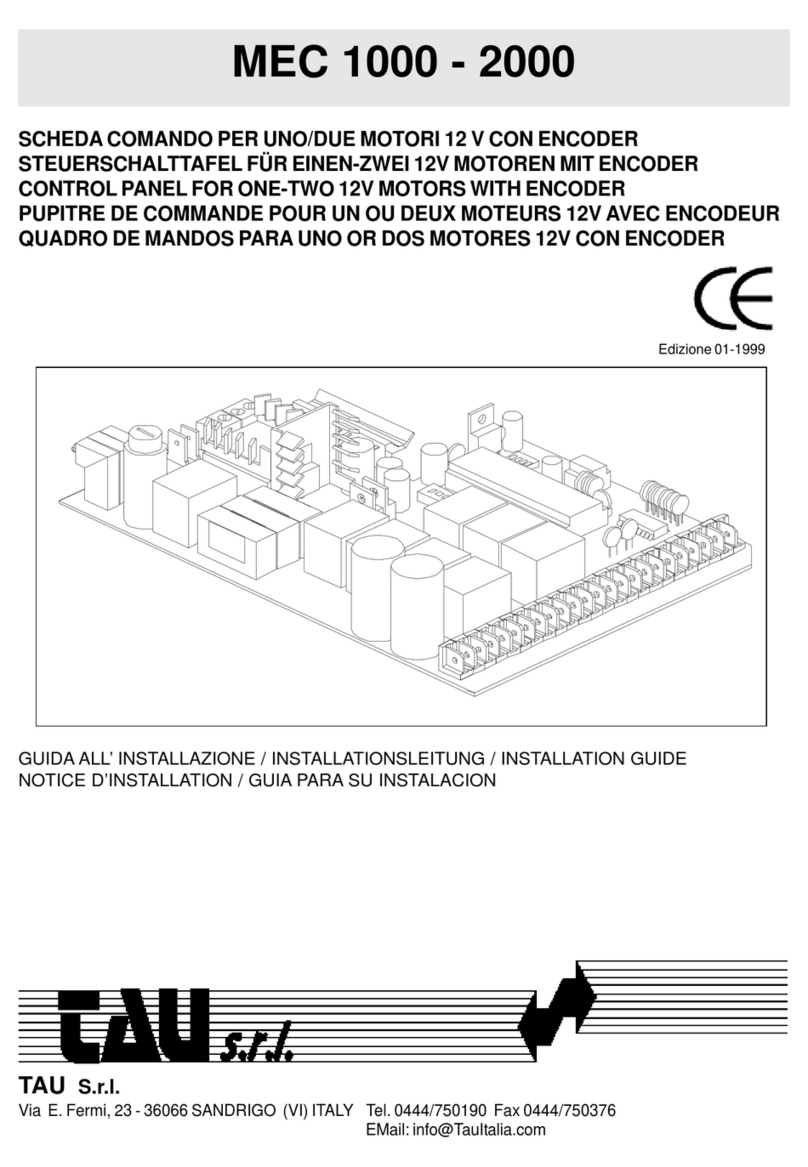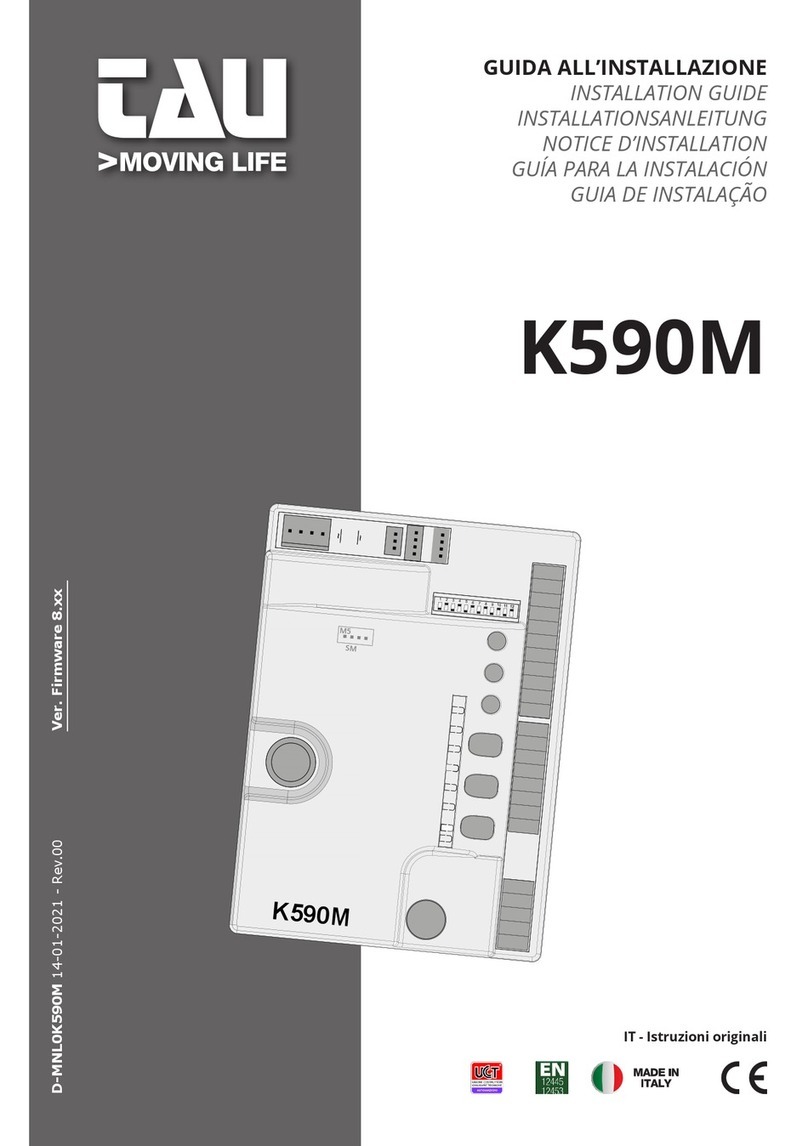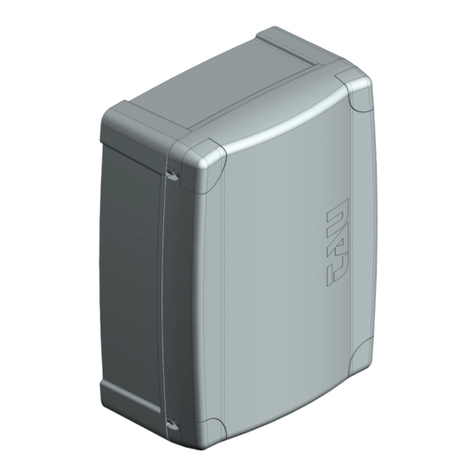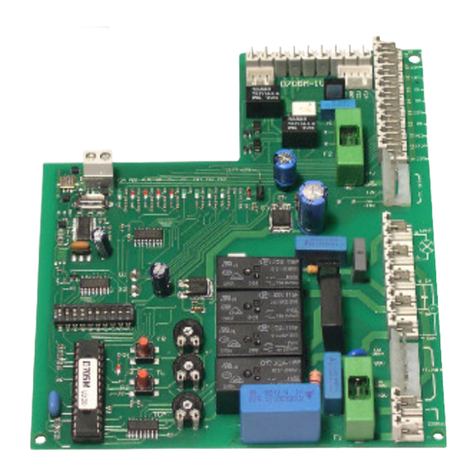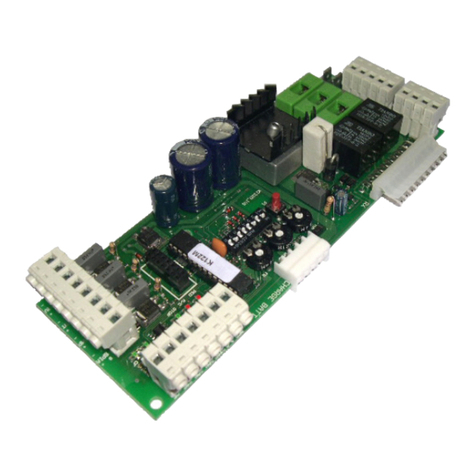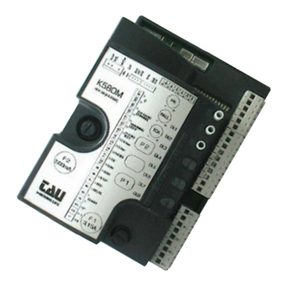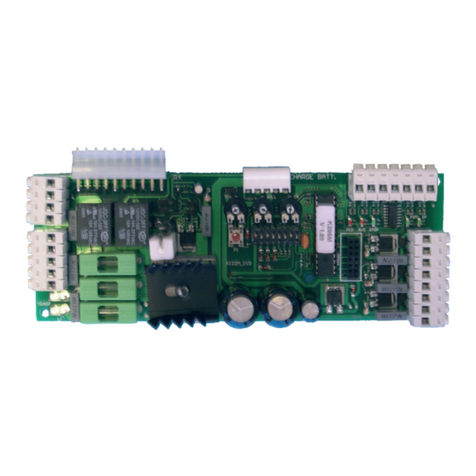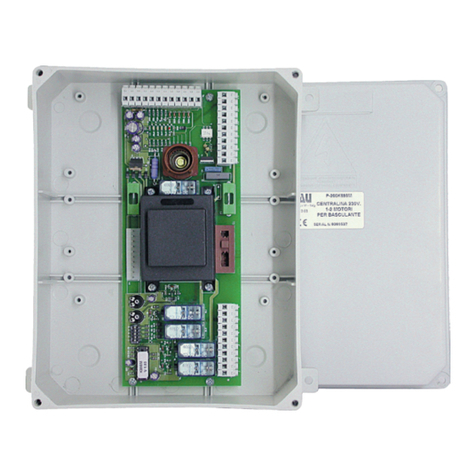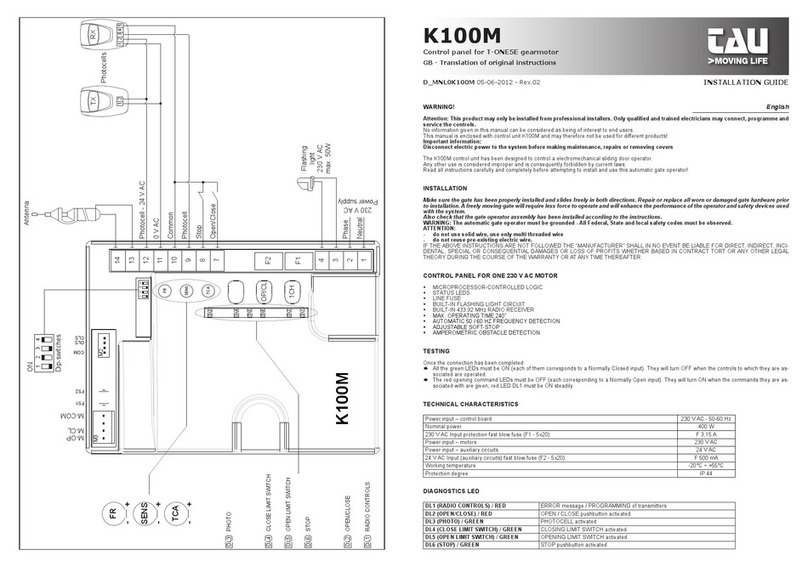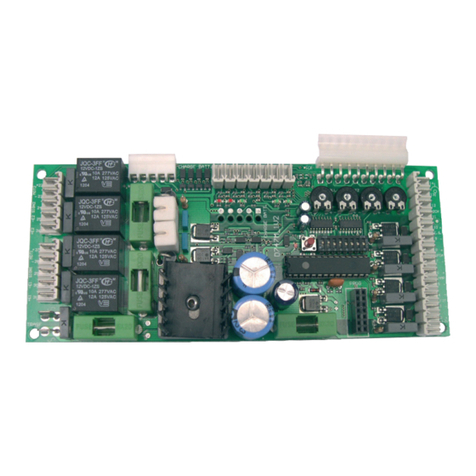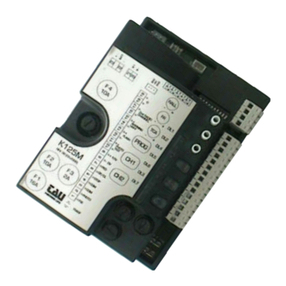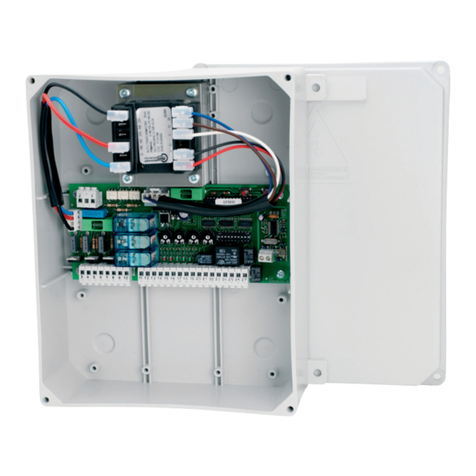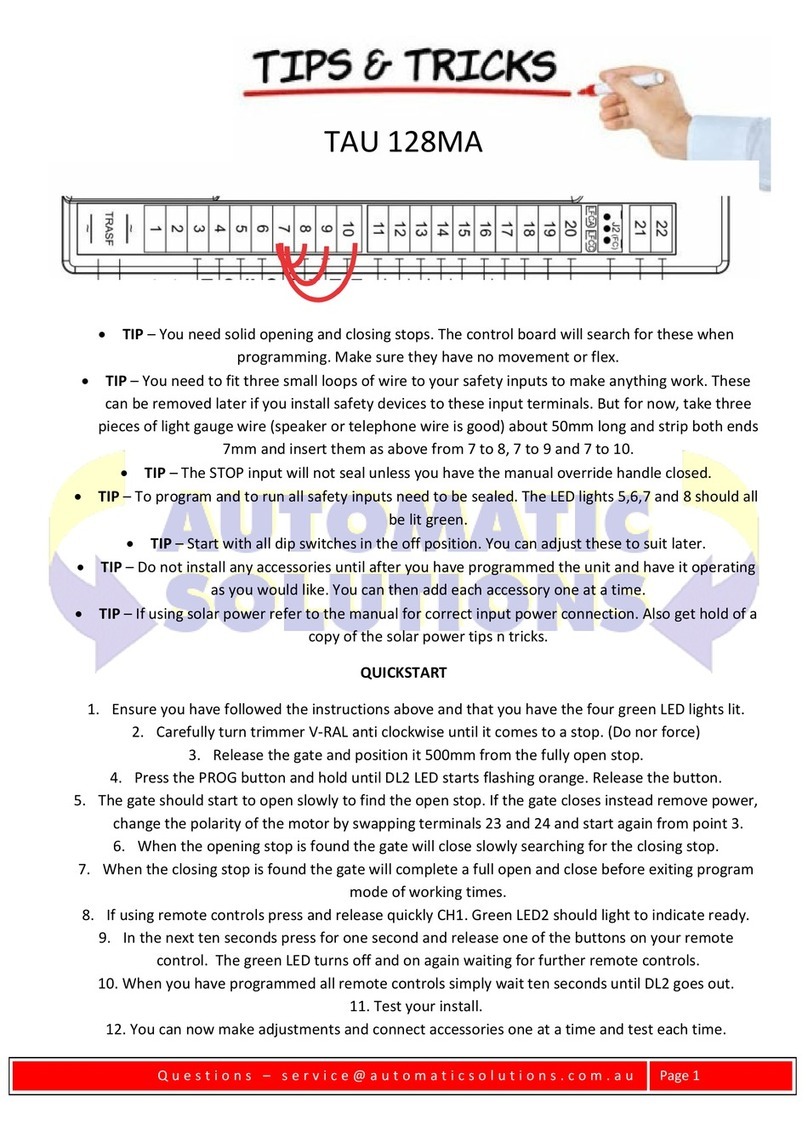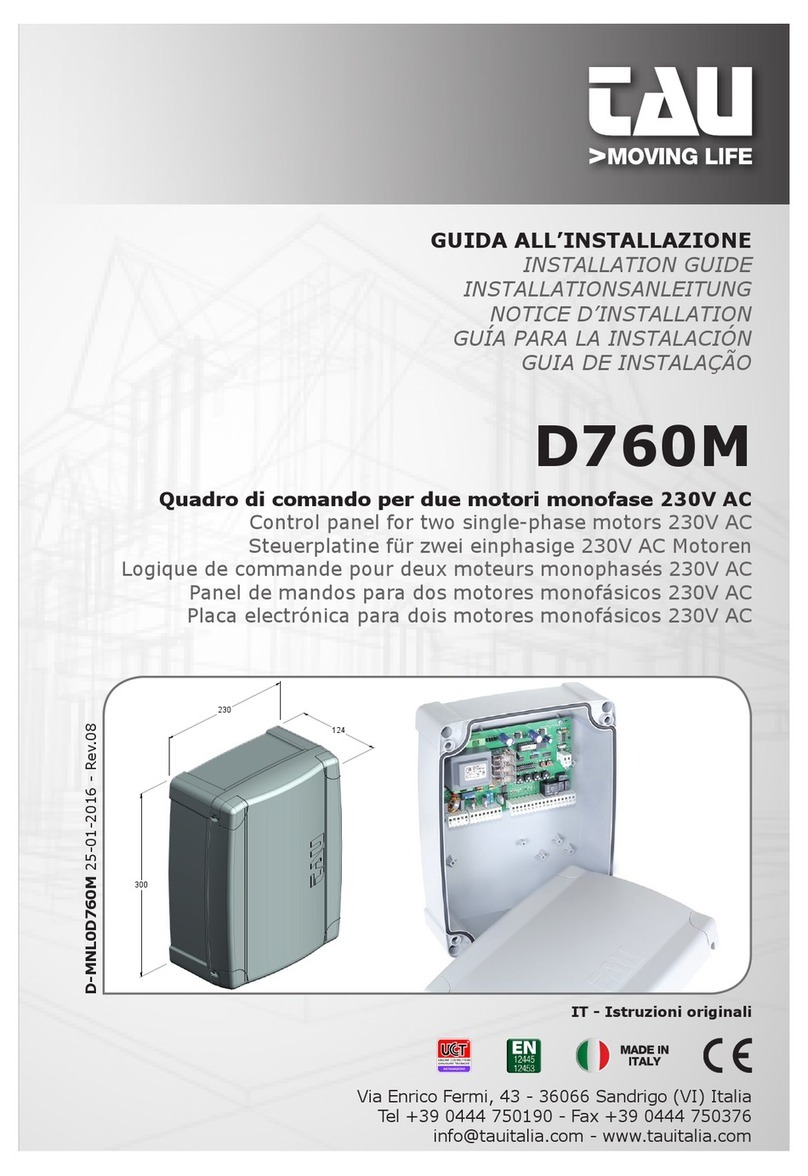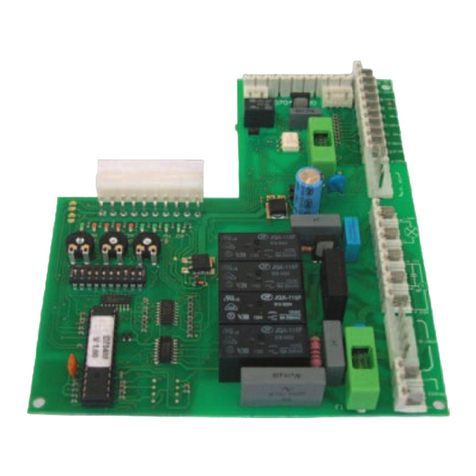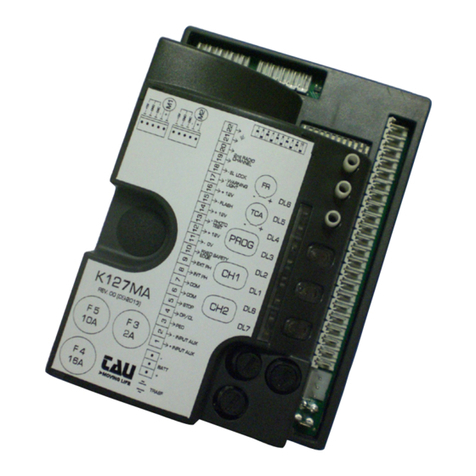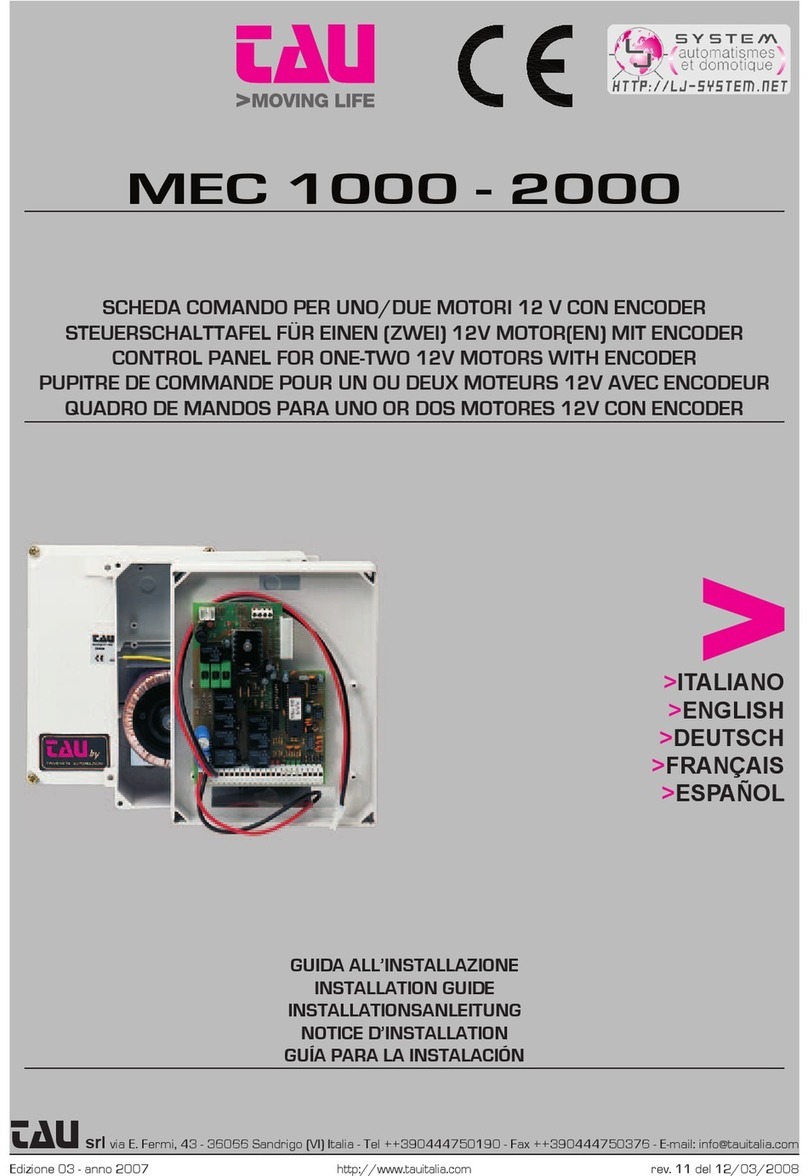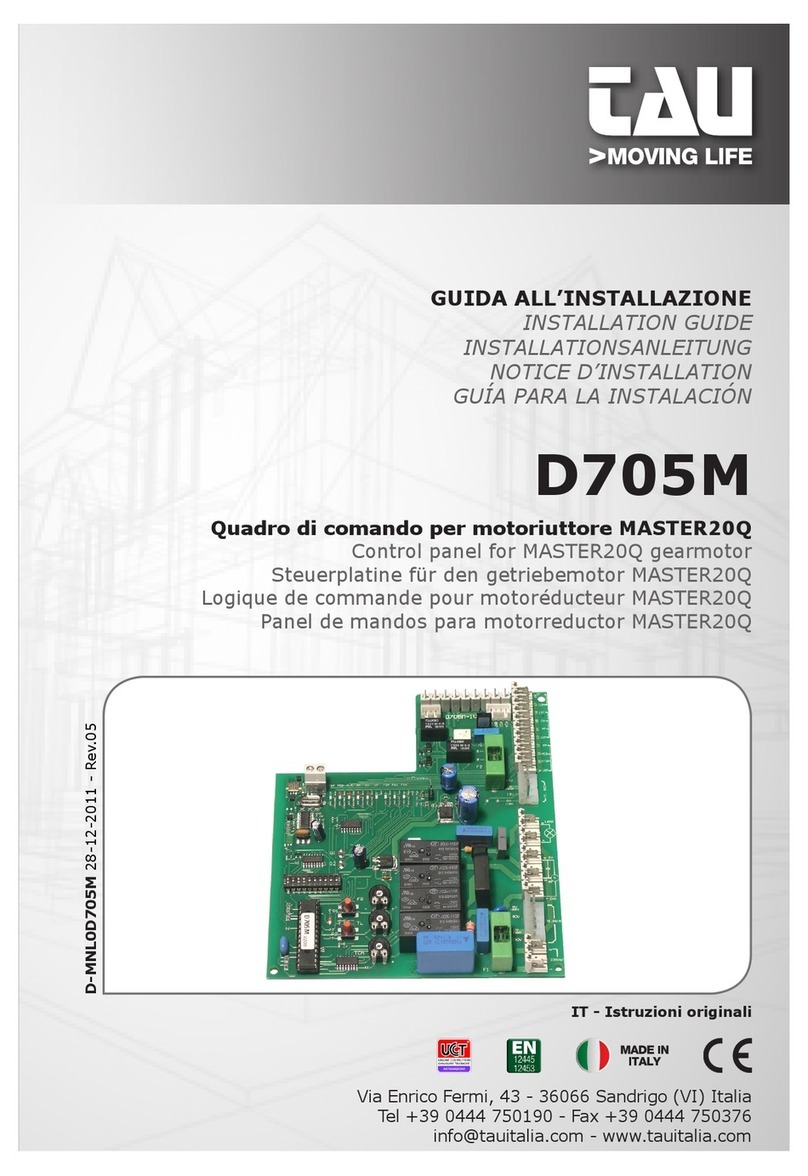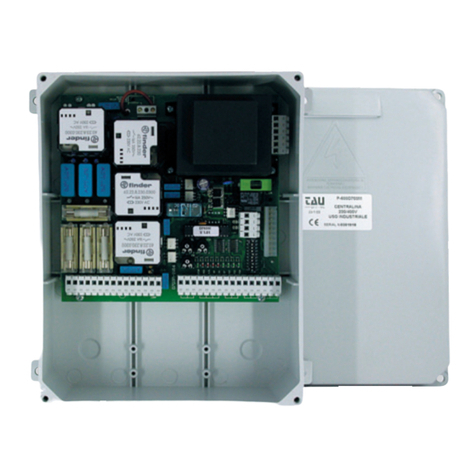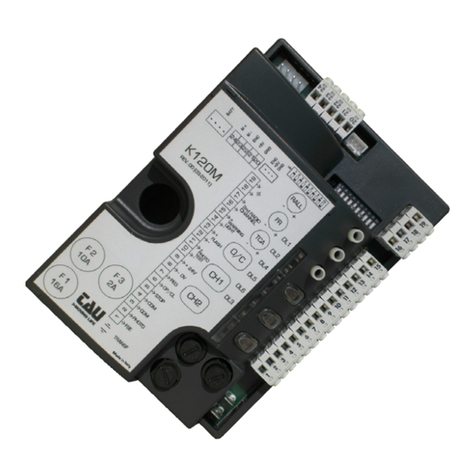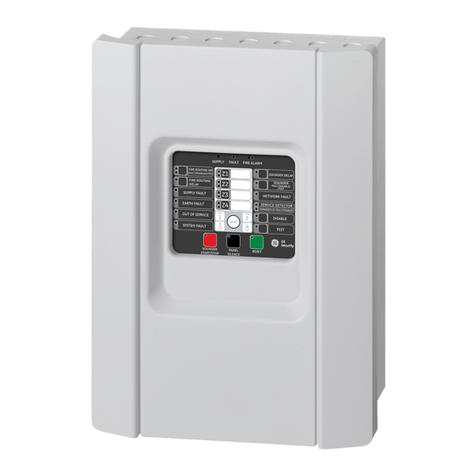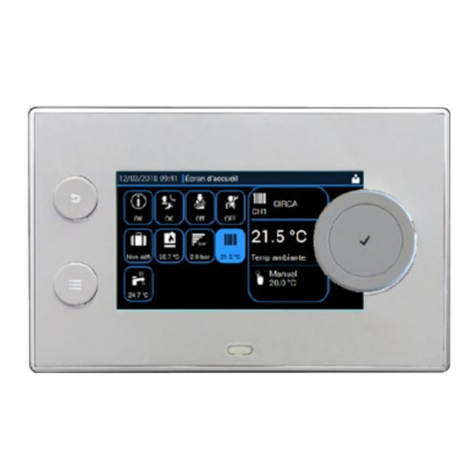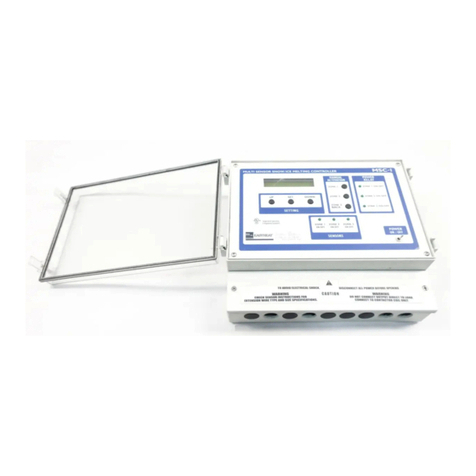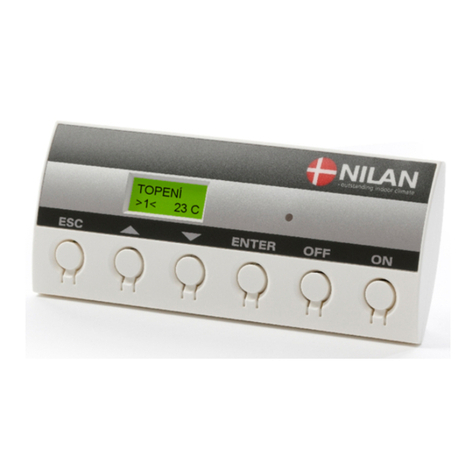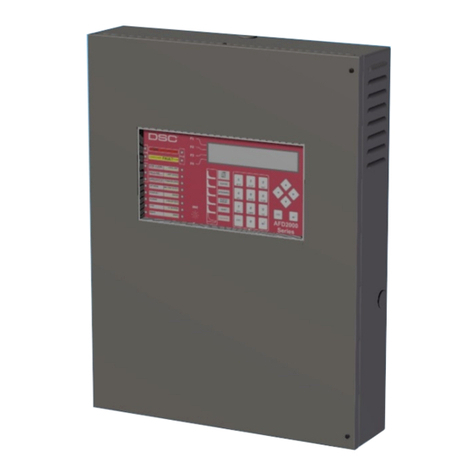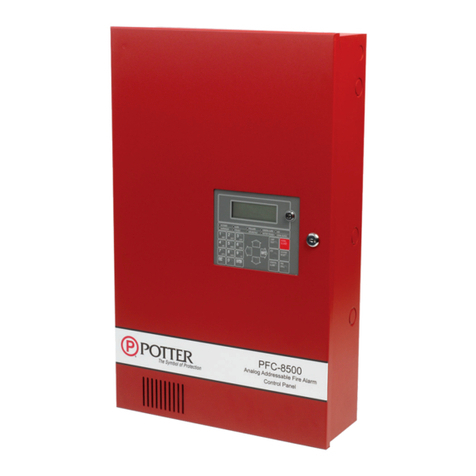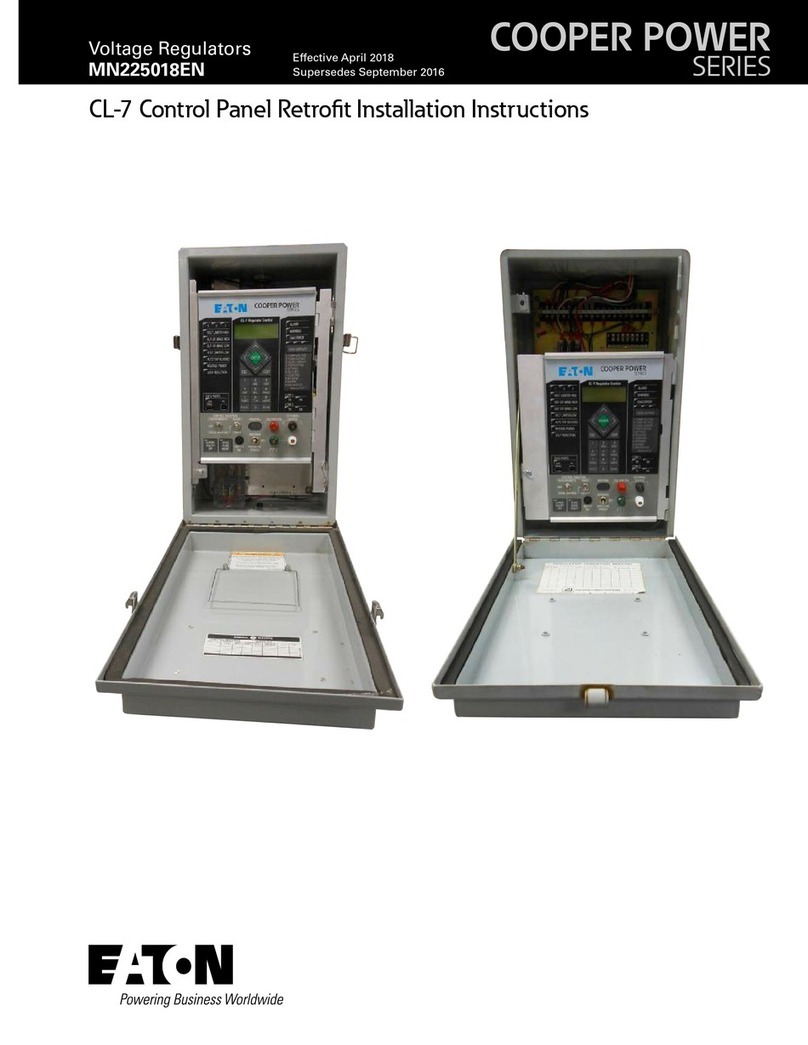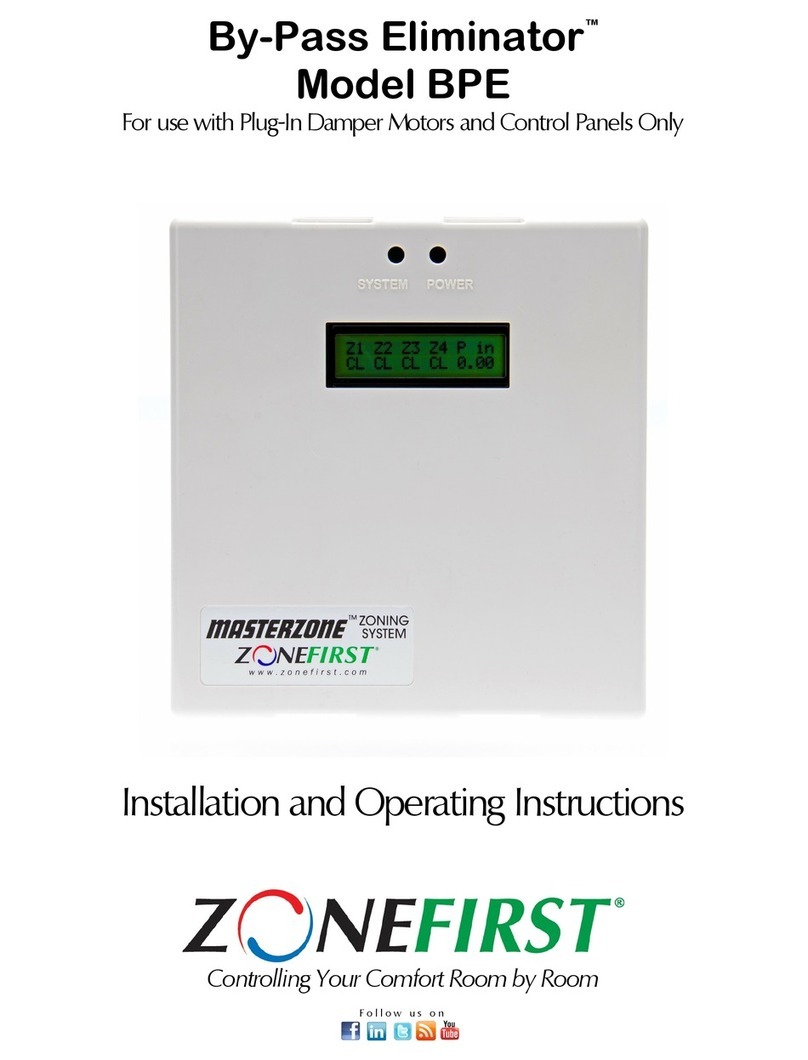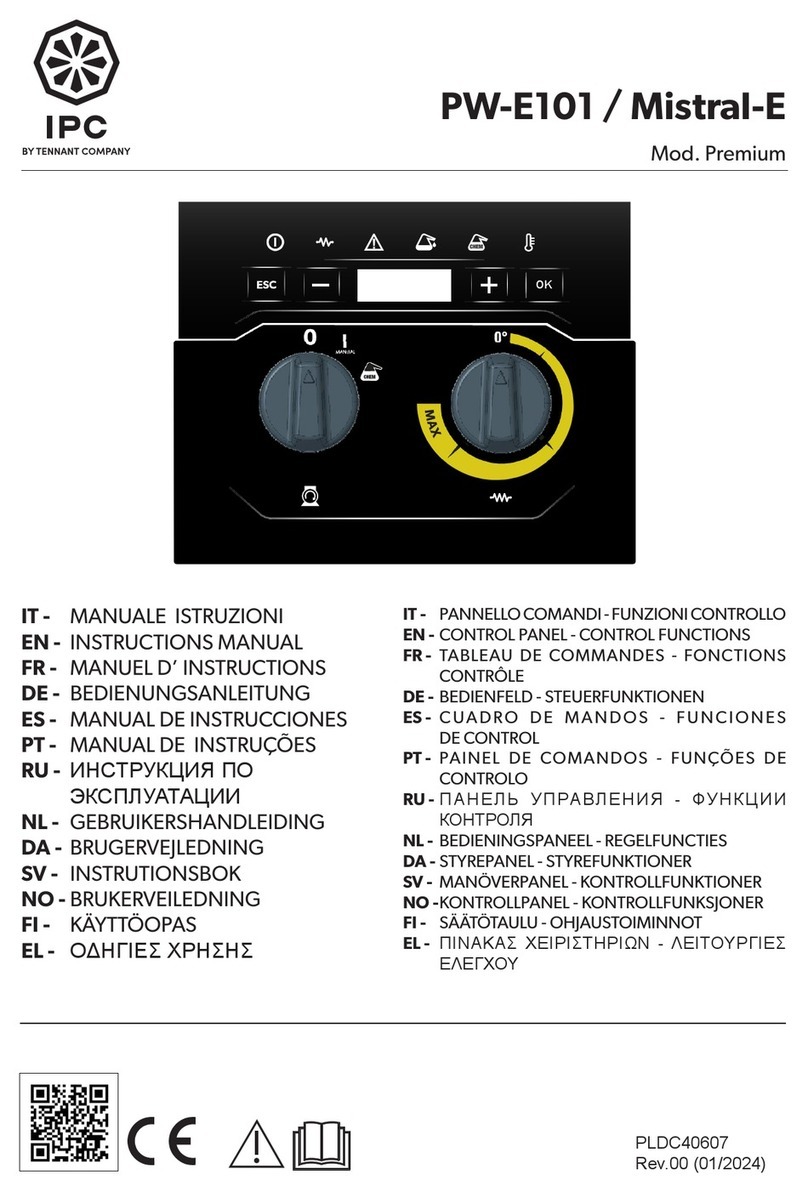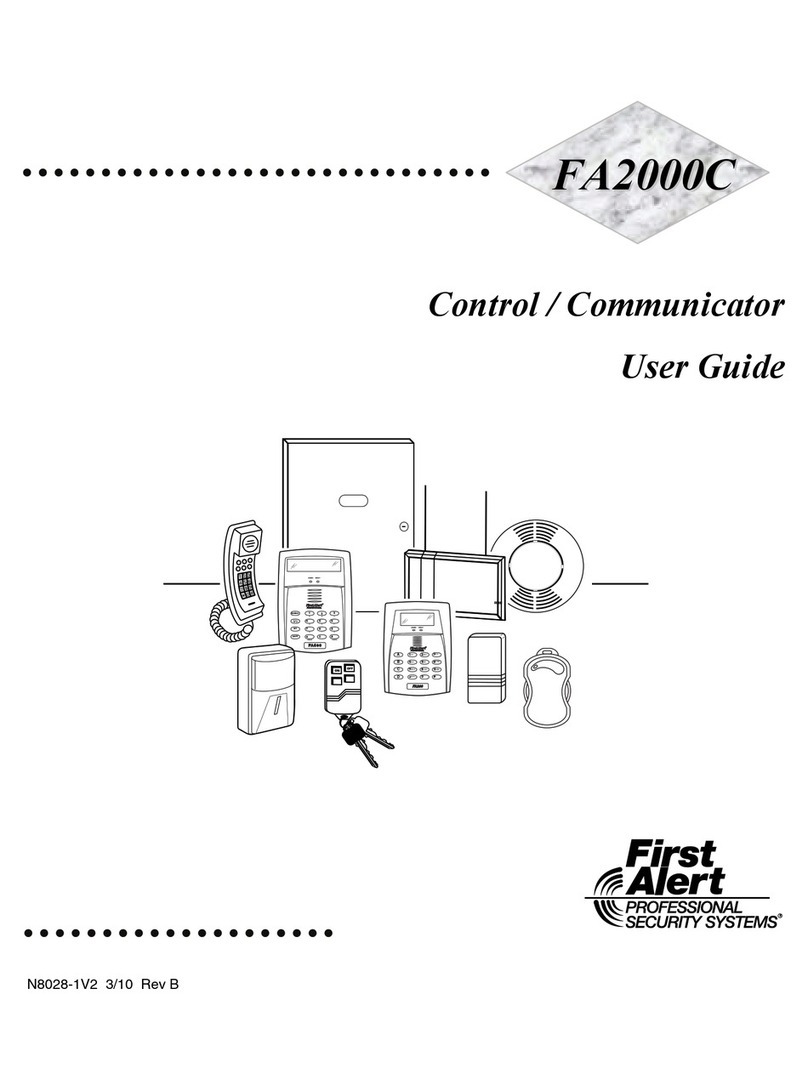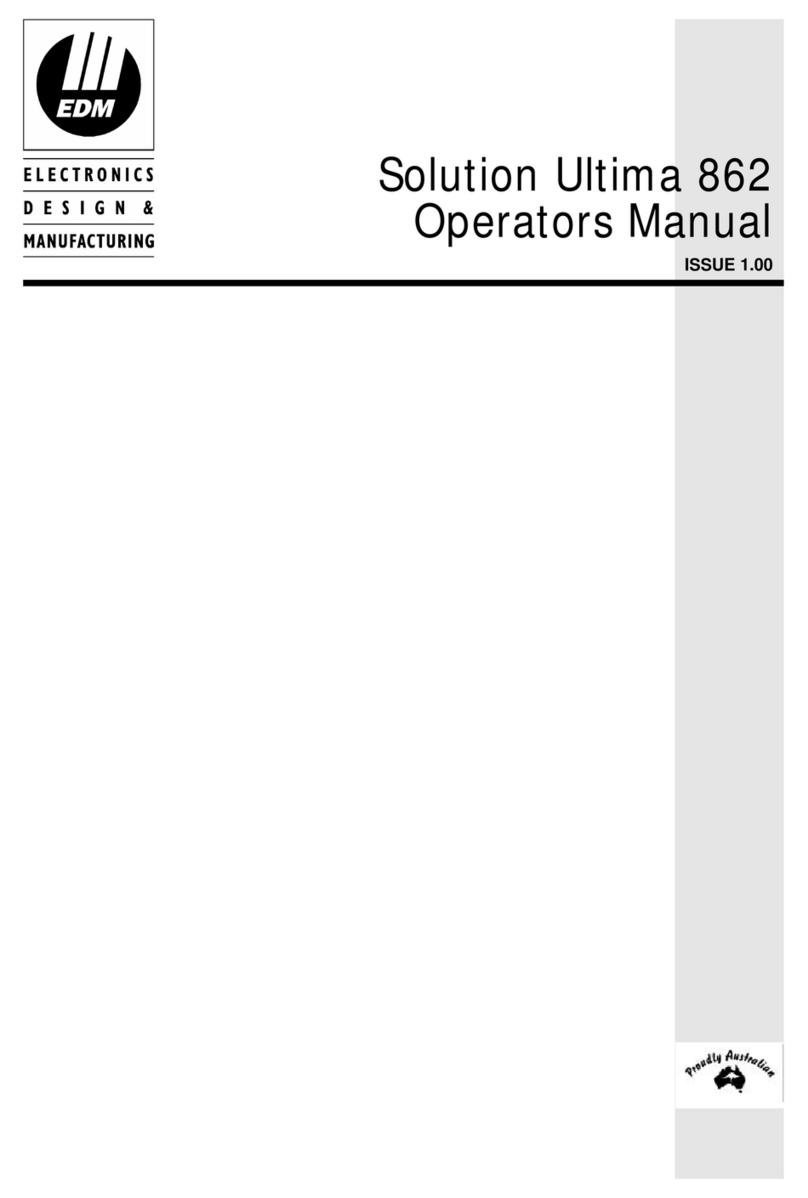tau K122M User manual

1
TAU Srl K122M
K122M
QUADRO DI COMANDO PER MOTORIDUTTORE SPEED 2
CONTROL PANEL FOR SPEED 2 GEARMOTOR
SCHALT- UND STEUERTAFEL FÜR DEN GETRIEBEMOTOR SPEED 2
LOGIQUE DE COMMANDE POUR MOTORÉDUCTEUR SPEED 2
PANEL DE MANDOS PARA MOTORREDUCTOR SPEED 2
GUIDA ALL’INSTALLAZIONE
INSTALLATION GUIDE
INSTALLATIONSANLEITUNG
NOTICE D’INSTALLATION
GUÍA PARA LA INSTALACIÓN
TAU srl via E. Fermi, 43 - 36066 Sandrigo (VI) Italia - Tel ++390444750190 - Fax ++390444750376 - E-mail: [email protected]
Edizione 02 - anno 2005 rev. 04 del 28/07/2005
http://www.tauitalia.com

2
TAU Srl
K122M
Introduzione
Il presente manuale è destinato solamente al personale tecnico qualificato per l’installazione.
Nessuna informazione contenuta nel presente fascicolo può essere considerata d’interesse per
l’utilizzatore finale. Questo manuale è allegato alla centralina K122M montata sul motoriduttore
Speed 2, non deve pertanto essere utilizzato per prodotti diversi!
Avvertenze importanti:
Togliere l’alimentazione di rete alla scheda prima di accedervi.
La centralina K122M è destinata al comando di un motoriduttore elettromeccanico in corrente
continua per l’automazione di cancelli scorrevoli.
Ogni altro uso è improprio e, quindi, vietato dalle normative vigenti.
È nostro dovere ricordare che l’automazione che state per eseguire, è classificata come
“costruzione di una macchina” e quindi ricade nel campo di applicazione della direttiva europea
98/37 CEE (Direttiva Macchine).
Questa, nei punti essenziali, prevede che:
- l’installazione deve essere eseguita solo da personale qualificato ed esperto;
- chi esegue l’installazione dovrà preventivamente eseguire “l’analisi dei rischi” della macchina;
- l’installazione dovrà essere fatta a “regola d’arte”, applicando cioè le norme;
- infine dovrà essere rilasciata al proprietario della macchina la”dichiarazione di conformità”.
Risulta chiaro quindi che l’installazione ed eventuali interventi di manutenzione devono essere
effettuati solo da personale professionalmente qualificato, in conformità a quanto previsto dalle
leggi, norme o direttive vigenti.
Nella progettazione delle proprie apparecchiature, TAU rispetta le normative applicabili al prodotto
(vedere la dichiarazione di conformità allegata); è fondamentale che anche l’installatore, nel
realizzare gli impianti, prosegua nel rispetto scrupoloso delle norme.
Personale non qualificato o non a conoscenza delle normative applicabili alla categoria dei “cancelli
e porte automatiche” deve assolutamente astenersi dall’eseguire installazioni ed impianti.
Chi non rispetta le normative è responsabile dei danni che l’impianto potrà causare!
Si consiglia di leggere attentamente tutte le istruzioni prima di procedere con l’installazione.
Italiano
Introduction
This manual is designed to assist qualified installation personnel only. It contains no information that
may be of interest to final users. This manual is attached to the K122M control unit mounted on the
Speed 2 gearmotor, therefore it may not be used for different products!
Important warnings:
Disconnect the mains power supply to the board before accessing it.
The K122M control unit is suitable for the control of a direct-current electromechanical gearmotor
for the automation of sliding gates.
Any other use is improper and forbidden by the regulations in force.
Please keep in mind that the automation system you are about to set up is classified as “machine
construction”, and is therefore regulated by European Directive 98/37 EEC (Machine Directive).
The essential provisions of this Directive are as follows:
- the installation must be performed by qualified and experienced personnel;
- those who carry out the installation must previously perform a risk analysis of the machine;
- theinstallationmustbeperformedinaworkmanlikemanner, therefore all the relevant regulations
must be observed;
- a “declaration of conformity” must be issued to the owner of the machine.
English
D-MNL0K122M

3
TAU Srl K122M
It is clear, therefore, that all the installation and maintenance operations must be performed by
qualified personnel in compliance with the provisions of the laws, regulations and directives in
force.
When designing its products, TAU observes all applicable standards (see the attached declaration
of conformity). It is of fundamental importance that also the installer, when setting up the system,
proceeds in strict compliance with all the relevant regulations.
Unqualified personnel, or those who are not familiar with the regulations that apply to “automatic
doors and gates” must absolutely abstain from executing installations or setting up systems.
Failure to comply with the regulations in force entails liability for any damage caused by the
system!
We recommend that you read all the instructions carefully before proceeding with the installation.
Einleitung
Das vorliegende Handbuch ist nur für technisches, zur Installation qualifiziertes Personal bestimmt.
Die im vorliegenden Heft enthaltenen Informationen sind für den Endbenutzer nicht interessant.
DieseAnleitung liegt der Steuerung K122M bei, die an den Getriebemotor Speed 2 montiert ist, und
darf daher nicht für andere Produkte verwendet werden!
Wichtige Hinweise:
Vor Eingriffen an der Steuerkarte die Netzstromversorgung abtrennen.
Die Steuerung K122M dient zum Steuern eines elektromechanischen Gleichstromgetriebemotors
für die Automatisierung von Schiebetoren.
Jeder andere Einsatz ist unsachgemäß und daher laut gültiger Vorschriften verboten.
Unsere Pflicht ist, Sie daran zu erinnern, dass die Automatisierung, die Sie ausführen werden,
als „Maschinenkonstruktion“ klassiert ist und daher zum Anwendungsbereich der Europäischen
Richtlinie 89/392 (Maschinenrichtlinie) gehört.
Nach den wichtigsten Punkten dieser Vorschrift:
- darf die Installation ausschließlich von erfahrenem Fachpersonal ausgeführt werden;
- muss jener, der die Installation ausführt, vorher eine „Risikoanalyse“ der Maschine machen;
- muss die Installation „fachgerecht“ bzw. unter Anwendung der Vorschriften ausgeführt sein;
- muss dem Besitzer der Maschine die „Konformitätserklärung“ ausgehändigt werden.
Es ist daher offensichtlich, dass Installation und eventuelle Wartungseingriffe nur von beruflich
qualifiziertem Personal in Übereinstimmung mit den Verordnungen der gültigen Gesetze, Normen
und Vorschriften ausgeführt werden dürfen.
Bei der Planung ihrer Apparaturen hält sich TAU an die für das Produkt anwendbaren Vorschriften
(siehe anliegende Konformitätserklärung); von grundlegender Wichtigkeit ist, dass sich auch der
Installateur bei der Durchführung der Anlage genauestens an die Vorschriften hält.
Personal,dasnichtqualifiziertistoderdieVorschriftennichtkennt,diefürdieKategorie„automatische
Türen und Tore“ anwendbar sind, darf Installationen und Anlagen keinesfalls ausführen.
Wer sich nicht an die Vorschriften hält, haftet für die Schäden, die von der Anlage verursacht
werden können.
Vor der Installation bitte alle Anweisungen genau lesen.
Deutsch

4
TAU Srl
K122M
Introduction
Le présent manuel est destiné exclusivement au personnel technique qualifié pour l’installation.
Aucune information contenue dans ce fascicule ne peut être considérée comme intéressante pour
l’utilisateur final.Ce manuel estjoint à la logiquede commande K122Mmontéesur le motoréducteur
Speed 2, il ne doit donc pas être utilisé pour des produits différents !
Recommandations importantes :
Couper l’alimentation électrique de la carte avant d’y accéder.
Lalogique de commande K122M estdestinéeàla commande d’un motoréducteurélectromécanique
pour l’automatisation de portails coulissants.
Toute autre utilisation est impropre et donc interdite par les normes en vigueur.
Nous nous devons de rappeler que l’automatisation que vous vous apprêtez à exécuter est classée
comme «construction d’une machine» et rentre donc dans le domaine d’application de la Directive
Européenne 89/392 CEE (Directive Machines).
Cette directive, dans ses grandes lignes, prévoit que :
- l’installation doit être exécutée exclusivement par du personnel qualifié et expert ;
- qui effectue l’installation devra procéder au préalable à «l’analyse des risques» de la
machine ;
- l’installation devra être faite dans les «règles de l’art», c’est-à-dire en appliquant les normes ;
- l’installateur devra remettre au propriétaire de la machine la «déclaration de conformité».
Ilestdoncclairquel’installation et les éventuelles interventionsdemaintenancedoiventêtreeffectuées
exclusivement par du personnel professionnellement qualifié, conformément aux prescriptions des
lois, normes ou directives en vigueur.
Dans le projet de ses appareils, TAU respecte les normes applicables au produit (voir la déclaration
de conformité jointe) ; il est fondamental que l’installateur lui aussi, lorsque qu’il réalise l’installation,
respecte scrupuleusement les normes.
Tout personnel nonqualifiéouneconnaissantpasles normes applicables à lacatégoriedes«portails
et portes automatiques» doit absolument s’abstenir d’effectuer des installations.
Qui ne respecte pas les normes est responsable des dommages que l’installation pourra causer !
Nous conseillons de lire attentivement toutes les instructions avant de procéder à l’installation.
Français
EspañolIntroducción
El presente manual está destinado sólo al personal técnico cualificado para la instalación. Las
informaciones que contiene este fascículo no pueden considerarse de interés para el usuario final.
Este manual se adjunta a la centralina K122M montada en el motorreductor Speed 2 y, por lo tanto,
no debe utilizarse para productos diversos.
Advertencias importantes:
Antes de acceder a la tarjeta es necesario desconectarla de la alimentación de red.
La centralina K122M está destinada al control de un motorreductor electromecánico de corriente
continua para la automatización de puertas correderas.
Cualquier otro tipo de uso se considera impropio y, por lo tanto, está prohibido por las normativas
vigentes.
Nos vemos obligados a recordar que la automatización que está a punto de montar está clasificada
como “construcción de una máquina” y, por lo tanto, se incluye en el campo de aplicación de la
directriz europea 98/37 CEE (Directriz Máquinas).
Esta directriz, en los puntos esenciales, prevé que:
- la instalación tiene que efectuarla sólo personal cualificado y experto;

5
TAU Srl K122M
- la persona que lleva acabo la instalación tendrá que efectuar de forma preventiva “el análisis
de los riesgos” de la máquina;
- la instalación tendrá que efectuarse “con todas las de la ley”, es decir, aplicando las normas;
- por último, será necesario entregar al propietario de la máquina la “declaración de
conformidad”.
Por lo tanto, queda claro que la instalación y las eventuales intervenciones de mantenimiento sólo
pueden efectuarlos personal profesional cualificado, conforme a lo previsto por las leyes, normas
o directrices vigentes.
Cuando proyecta sus propios equipos, TAU respeta las normativas aplicables al producto (véase
la declaración de conformidad adjunta); es fundamental que el instalador, cuando lleva a cabo las
instalaciones, respete también de forma escrupulosa las normas.
Elpersonalnocualificadooquedesconocelasnormativasaplicablesalacategoríadelas “cancelas y
puertas automáticas” tiene que abstenerse absolutamente de efectuar este tipo de instalaciones.
Laspersonas que no respetenlasnormativasserán considerados responsables delosdesperfectos
que pueda causar la instalación.
Se aconseja leer atentamente todas las instrucciones antes de pasar a la instalación.
95
200
15

6
TAU Srl
K122M
5
6
Lamp
18Vdc
max 20W
9
9
1
1
0
0
1
1
1
1
Comune
Fotocellula
Costa fissa
Fotocellula
RX TX
1234
7
8
Spia cancello
aperto max
3W
12
1314
15
Pedonale
Comune
Apre/Chiude
Stop
17
16
Antenna
2°Ch. RX
19
18
Encoder
Segnale
Negativo -
22
21
20
Positivo +
23
24
M
FS1
FS2

7
TAU Srl K122M
INDICE
CONTENTS
INHALTSVERZEICHNIS
INDEX
ÍNDICE
Pag. 8 ITALIANO
Pag. 14 ENGLISH
Pag. 20 DEUTSCH
Pag. 26 FRANÇAIS
Pag. 32 ESPAÑOL
Pag. 38 SCHEMA CABLAGGIO K122M / K122M WIRING DIAGRAM / SCHALTPLAN DER
K122M / SCHÉMA CÂBLAGE K122M / ESQUEMA DEL CABLEADO K122M
Pag. 40 SCHEDA BATTERIA (OPZIONALE) / BATTERY CHARGER BOARD (OPTIONAL)
/ BATTERIELADEKARTE (OPTIONAL) / CARTE CHARGEUR DE BATTERIE (EN
OPTION) / TARJETA CARGA BATERÍA (OPCIONAL)
Pag. 41 DICHIARAZIONE CE / KONFORMITÄTSERKLÄRUNG / DECLARATION OF
CONFORMITY / DECLARATlON DE CONFORMITY / DECLARACIÓN DE
CONFORMIDAD
Pag. 42 GARANZIA / GARANTIE / GUARANTEE / GARANTIE / GARANTÍA

8
TAU Srl
K122M
Italiano
SCHEDA COMANDO PER MOTORIDUTTORE SPEED 2
LOGICA CON MICROPROCESSORE
STATO DEGLI INGRESSI VISUALIZZATO DA LEDs
FUNZIONE “INGRESSO PEDONALE”
CIRCUITO DI LAMPEGGIO INCORPORATO
SENSORE AD ENCODER PER RILEVAMENTO OSTACOLI ED AUTOAPPRENDIMENTO DELLA
CORSA
CONNETTORE PER RICEVENTE
CONNETTORE PER BATTERIA E CARICA BATTERIA (OPZIONALE)
DIAGNOSTICA DEL DIFETTO FUNZIONE VISUALIZZATO DA LED
COLLAUDO
A collegamento ultimato:
¨ILeds verdi LS devonoesseretutti accesi (corrispondonociascunoadun ingresso Normalmente
Chiuso). Si spengono solo quando sono interessati i comandi ai quali sono associati.
¨I Leds rossi LS devono essere tutti spenti (corrispondono ciascuno ad un ingresso Normalmente
Aperto) si accendono solo quando sono interessati i comandi ai quali sono associati.
INSTALLAZIONE
Prima di procedere assicurarsi del buon funzionamento della parte meccanica. Verificare
inoltre che il gruppo motoriduttore sia stato installato correttamente seguendo le
relative istruzioni. Eseguiti questi controlli, assicurarsi che il motoriduttore non abbia un
assorbimento durante il movimento superiore a 3 A (per un corretto funzionamento del
quadro di comando).
L’INSTALLAZIONE DELL’APPARECCHIATURA DEVE ESSERE EFFETTUATA “A REGOLA
D’ARTE” DAPERSONALE QUALIFICATO COME DISPOSTO DALLA LEGGE 46/90.
NB : si ricorda l’obbligo di mettere a massa l’impianto nonché di rispettare le normative sulla
sicurezza in vigore in ciascun paese.
LANON OSSERVANZADELLE SOPRAELENCATE ISTRUZIONI PUÒ PREGIUDICARE IL BUON
FUNZIONAMENTO DELL’APPARECCHIATURA E CREARE PERICOLO PER LE PERSONE,
PERTANTO LA “CASA COSTRUTTRICE” DECLINA OGNI RESPONSABILITÀ PER EVENTUALI
MAL FUNZIONAMENTI E DANNI DOVUTI ALLA LORO INOSSERVANZA.
CARATTERISTICHE TECNICHE
Alimentazione scheda 13,5 Vac - 50 Hz
Potenza max. motore c.c. 50 W - 18 Vdc
Fusibile rapido protezione alimentazione ingresso 13,5 Vac (F1 - 5x20) F 16A
Fusibile rapido protezione motore (F2 - 5x20) F 10A
Fusibile rapido protezione ausiliari 18 V dc (F3 - 5x20) F 1,6A
Tensione circuiti alimentazione motore 18 Vdc
Tensione alimentazione circuiti dispositivi ausiliari 18 Vdc
Tensioni alimentazioni circuiti logici 5 Vdc
Temperatura di funzionamento -20 °C ÷ +70 °C

9
TAU Srl K122M
COLLEGAMENTI ALLA MORSETTIERA
1 - 2 uscita ausiliari 18 Vdc max. 15 W (1 = NEGATIVO - 2 = POSITIVO) per fotocellule, relay,
ricevitori, etc...;
3 - 4 uscita 18 Vdc fotocellula trasmittente -fototest- (3 = NEGATIVO - 4 = POSITIVO) max. nr.
1 trasmettitore fotocellule;
5 - 6 uscita 18 Vdc max. 20W alimentazione lampeggiante (5 = NEGATIVO - 6 = POSITIVO),
lampeggio fornito dalla centrale, veloce in chiusura e lento in apertura;
7 - 8 uscita18Vdcmax.3Walimentazione spia cancello aperto e in movimento (7 = NEGATIVO
- 8 = POSITIVO);
9 - 11 ingresso N.C. bordo sensibile elettromeccanico - interviene durante l’apertura bloccando
e richiudendo il cancello per ~20 cm (9 = C.F. - 11 = COM);
10 - 11 ingresso N.C. fotocellule - interviene durante la chiusura o anche durante l’apertura, vedi
dip-switch nr. 3 (10 = FOT - 11 = COM);
N.B. Il trasmettittore della fotocellula deve sempre essere alimentato dai morsetti nr 3 e nr
4, in quanto su di esso si effettua la verifica del sistema di sicurezza (Fototest). Senza
questo collegamento, la centralina non funziona. Per eliminare la verifica del sistema
di sicurezza, o quando non si usano le fotocellule, porre il dip-switch nr 6 in OFF.
12 - 13 ingresso N.C. pulsante STOP - Arresta il cancello dovunque si trovi, inibendo
temporaneamente la chiusura automatica, se programmata (12 = COM - 13 = STOP);
12 - 14 ingresso N.A. pulsante APRE/CHIUDE - Comanda l’apertura e la chiusura del cancello
ed è regolato nel funzionamento dai dip-switches 2 e 3 ( 12 = COM - 14 = A/C);
12 - 15 ingresso N.A. pulsante PEDONALE - Comanda l’apertura e la chiusura parziale del
cancello per ~1 m di corsa ed è regolato nel funzionamento dai dip-switches 2 e 3 (12 =
COM - 15 = PED);
16 - 17 ingresso antennaradioriceventeadinnestosoloperricevitori40,665MHz(16=SEGNALE
- 17 = MASSA);
18 - 19 uscita 2° canale radio - per comandare un’altra automazione o accendere luci, etc...
(contatto pulito N.A.);
20 - 21 - 22 alimentazione e ingresso encoder (20 = MARRONE positivo - 21 = BIANCO segnale
- 22 = BLU negativo);
23 - 24 uscita alimentazione motore 18 Vdc max. 50 W;
FS1 - FS2 ingressoalimentazionescheda13,5Vac-Alimentatodaltrasformatoretoroidaleriposto
nell’apposito vano del motore SPEED 2 e protetto da fusibile sull’alimentazione 230
Vac;
PROCEDURA DI MEMORIZZAZIONE
ATTENZIONE: Dopo aver alimentato il quadro di comando attendere 2 sec. prima di iniziare
a svolgere le manovre di regolazione.
N.B. Il cancello deve necessariamente avere i necessari fermi di sicurezza sia in apertura
che in chiusura.

10
TAU Srl
K122M
Terminata l’installazione dell’automazione:
1_ portare il cancello a 1 m ca. dalla battuta in chiusura;
2_ posizionare il dip-switch nr. 8 in ON;
3_ comandare l’automazione agendo su uno dei seguenti ingressi: A/C, radiocomando o pulsante
scheda.
4_ il cancello deve cominciare a chiudere.
N.B.: nel caso dovesse aprirsi, sospendere la programmazione resettando il quadro elettrico
(togliere l’alimentazione al quadro per almeno 5 sec. e rimettere il dip-switch nr. 8 in
OFF), e quindi a quadro disalimentato invertire tra di loro i fili di alimentazione del
motore. Riprendere poi la procedura dal punto 1.
5_ effettuata la chiusura, trascorso un tempo di circa 2 sec., viene eseguita automaticamente
un’apertura totale;
6_ ad apertura completata, posizionare il dip-switch nr. 8 in OFF;
7_ l’automazione è ora pronta per il funzionamento.
Effettuare le regolazioni logiche.
N.B.: agendo su qualsiasi regolazione del quadro di comando (trimmer o dip-switches) è
necessario effettuare una manovra completa (apertura e chiusura) dell’automazione
per rendere attive le nuove impostazioni.
REGOLAZIONI LOGICHE
TRIMMER
RALL. regolazione distanza di rallentamento: da 10 a 100 cm ca.;
T.C.A. regolazione Tempo di Chiusura Automatica: da 3 a 255 secondi ca. (vedi dip-switch nr.
1);
FR. regolazione sensibilità rilevamento ostacoli.
NOTA: ruotandoilTRIMMERFR.insensoorariosi diminuiscelasensibilità delmotoriduttore
sull’ostacolo e quindi aumenta la forza di spinta; viceversa, ruotandolo in senso
antiorario, aumenta la sensibilità del motoriduttore sull’ostacolo e diminuisce la
forza di spinta.
Dip switch
1 on: ad apertura completata, la chiusura del cancello è automatica trascorso un tempo impostato
sul trimmer T.C.A.;
off: la chiusura necessita di un comando manuale;
2 on: adautomazionefunzionante, una sequenza di comandi di apertura/chiusura induceilcancello
ad una APERTURA-CHIUSURA-APERTURA-CHIUSURA, etc.
off: nellestessecondizioni,la stessa sequenza di comandiinduceilcancelloadunaAPERTURA-
STOP-CHIUSURA-STOP-APERTURA-STOP, etc. (funzione passo-passo) (vedi anche dip switch
4);
3 on: durante la fase di apertura la fotocellula interviene arrestando il cancello fino a rimozione
dell’ostacolo rilevato. In fase di chiusura provoca l’arresto seguito dalla totale riapertura del
cancello;
off: durantelafase di apertura la fotocellulanoninterviene,mentreinfase di chiusura sicomporta
come in modalità on;
4on: il cancello si comporta come stabilito dal dip switch nr. 2
off: il cancello ignora i comandi di chiusura durante l’apertura;
5 on: la funzione prelampeggio è inserita;
off: la funzione prelampeggio è disinserita;
6 on: la funzione “verifica delle fotocellule” è inserita;
off: la funzione “verifica delle fotocellule” è disinserita. N.B.: da utilizzare quando non si usano
le fotocellule;
7 on: in seguito all’intervento del contatto fotocellula (ingresso 10 - 11), l’automazione si chiude
automaticamente dopo 5 secondi;
off: funzione disinserita;

11
TAU Srl K122M
TL TCA FR
-+
-+-+
ON
12345678910
CN1
TL TCA FR
-+
-+-+
ON
12345678910
Dip-switches
8 on: si abilita la funzione di memorizzazione per l’autoapprendimento della corsa;
off: posizione in cui lasciare il dip-switch al termine della procedura di memorizzazione.
Funzione orologio:
È possibile utilizzare un timer (esempio settimanale) collegato all’ingresso del pulsante apre-
chiude per mantenere aperto il cancello in determinate fascie orarie e permetterne poi la richiusura
automaitca.
CARATTERISTICHE DELLA K122M
LED - DL3
Il led, oltre ad indicare la presenza dell’alimentazione, segnala eventuali errori con una serie di
lampeggi predefiniti:
• sempre acceso: funzionamento regolare;
• 1 lampeggio: tensione della batteria tampone inferiore a 11,3 Vdc;
Controllare l’alimentazione di rete, caricare la batteria, sostituire la batteria;
• 2 lampeggi: errore fototest;
Disabilitare fototest (dip-switch 6 in OFF), verificare funzionamento fotocellule e loro collega-
mento;
• 3 lampeggi: mancanza tensione di rete;
Controllare interruttore magnetotermico (a monte dell’impianto), controllare fusibili;
• 4 lampeggi: superamento limite max. di corrente;
Picco di eccessivo assorbimento del motoriduttore, controllare l’assenza di ostacoli lungo la cor-
sa del cancello, verificare l’assorbimento di corrente del motore a vuoto e applicato al cancello;
• 5 lampeggi: assenza segnale encoder;
Controllare cablaggio, verificare encoder tramite TEST-ENCODER (opzionale)
• 6 lampeggi: presenza ostacolo dopo 5 tentativi di chiusura falliti;
Controllare l’assenza di ostacoli lungo la corsa del cancello e la scorrevolezza dello stesso;
• 7 lampeggi: non è stata eseguita alcuna procedura di memorizzazione;
Eseguire procedura di memorizzazione.
• 8 lampeggi: superamento del nr. max. di manovre programmate (opzionale).
Resettare conteggio manovre
N.B.: la versione del microprocessore installato nel quadro di comando in vostro possesso
non è abilitata al conteggio del nr. di manovre.
L’indicazione di più errori viene eseguita con una pausa di 2 sec. tra una segnalazione e l’altra.
L’indicazione degli errori persiste fino all’esecuzione di una manovra completa (apertura e chiusura)
dell’automazione.
Nel caso di 5 interventi consecutivi (durante la stessa manovra di apertura o chiusura) da parte
dei sistemi di sicurezza, la centrale entrerà in fase di corsa rallentata alla ricerca della battuta in

12
TAU Srl
K122M
chiusura.Énecessariochel’automazionecompletiuna manovra (apertura e successiva chiusura) per
resettarsi, altrimenti ripartirà la fase di ricerca della battuta di fine corsa dopo ogni singolo intervento
dei dispositivi di sicurezza.
LAMPEGGIANTE (18 Vdc - max. 20W)
Oltre a segnalare l’apertura e la chiusura dell’automazione, al termine della monovra (apertura o
chiusura), segnala eventuali errori con una serie di lampeggi predefiniti per un tempo max.- di 30
sec.
• sempre acceso: funzionamento regolare;
• 1 lampeggio: tensione della batteria tampone inferiore a 11,3 Vdc;
Controllare l’alimentazione di rete, caricare la batteria, sostituire la batteria.
• 2 lampeggi: errore fototest;
Disabilitare fototest (dip-switch 6 in OFF)
• 3 lampeggi: mancanza tensione di rete;
Controllare interruttore magnetotermico (a monte dell’impianto), controllare contatore.
• 4 lampeggi: superamento limite max. di corrente;
Picco di eccessivo assorbimento del motoriduttore, controllare l’assenza di ostacoli lungo la
corsa del cancello.
• 5 lampeggi: assenza segnale encoder;
Controllare cablaggio, verificare encoder tramite TEST-ENCODER (opzionale).
• 6 lampeggi: presenza ostacolo dopo 5 tentativi di chiusura falliti;
Controllare l’assenza di ostacoli lungo la corsa del cancello.
• 7 lampeggi: non è stata esgeuita alcuna procedura di memorizzazione;
Eseguire procedura di memorizzazione.
• 8 lampeggi: superamento del nr. max. di manovre programmate (opzionale).
Resettare conteggio manovre
N.B.: la versione del microprocessore installato nel quadro di comando in vostro possesso
non è abilitata al conteggio del nr. di manovre.
L’indicazione di più errori viene eseguita con una pausa di 2 sec. tra una segnalazione e l’altra.
L’indicazione degli errori persiste fino all’esecuzione di una manovra completa (apertura e chiusura)
dell’automazione.
SPIA CANCELLO APERTO (18 Vdc - max. 3W)
La spia cancello aperto, durante la fase di apertura o chiusura dell’automazione, lampeggia in
sincronia con il lampeggiante per rimanere poi fissa al raggiungimento dell’apertura totale. Una volta
completata anche la fase di chiusura, questa si spegne.
La spia cancello aperto ha inoltre la funzione di segnalare:
• fase di programmazione (quando il dip-switch 8 è in ON);
lampeggia in sincronia con il lampeggiante;
• ripristino della tensione di rete
emette una serie di lampeggi per un tempo di 2 sec. ca.;
• presenza di eventuali ostacoli lungo la corsa dell’automazione dopo 5 tentativi di chiusura
falliti;
lampeggia in sincronia con il lampeggiante.
SCHEDA CARICA BATTERIA (OPZIONALE)
Se si possiede la scheda carica batteria, in assenza di rete l’automazione risulta comunque
funzionante. Nel caso la tensione scenda sotto gli 11,3 Vdc, l’automazione cessa di funzionare (il
quadro di comando rimane alimentato); quando, invece, scende sotto i 10,2 Vdc, la scheda sgancia
completamente la batteria (il quadro di comando non è più alimentato).

13
TAU Srl K122M
RILEVAMENTO OSTACOLI
La funzione di rilevamento ostacoli (impostabile tramite trimmer FR) intervenendo in fase di apertura
dell’automazioneprovocauna richiusura della stessa di 20cmca.,mentreinfase di chiusura provoca
un’apertura totale.
ATTENZIONE: la logica del quadro di comando può interpretare un attrito meccanico per un
eventuale ostacolo.
RALLENTAMENTO
Perevitareche il cancello sbatta allafinedellacorsa,èpossibile impostare (tramite il trimmerRALL)il
rallentamentoin apertura e inchiusurasuuna distanza variabileda10a 100 cm. (ruotandoiltrimmer
in senso orario si aumenta la distanza di rallentamento; viceversa, ruotandolo in senso antiorario la
distanza di rallentamento si accorcia). Si consiglia di impostare la distanza di rallentamento tenedo
conto del peso del cancello e degli attriti meccanici in gioco.
N.B.: il pulsante P1 della scheda ha la stessa funzione del tasto APRE/CHIUDE.
APERTURA E CHIUSURA COMANDATA DA OROLOGIO
É possibile comandare l’apertura e la chiusura del cancello mediante un orologio digitale che in
uscita disponga di un contatto relè.
Sarà sufficiente collegarlo ai morsetti 12 - 14 (pulsante APRE/CHIUDE) e programmarlo in modo
che,all’ora di apertura desiderata,ilcontatto relè dell’orologio sichiudasinoall’ora di chiusuravoluta
(momento in cui il contatto relè dell’orologio si apre nuovamente, permettendo così la richiusura
automatica).
N.B.: La richiusura automatica deve essere inserita (Dip-switch nr. 1 in ON).
MALFUNZIONAMENTI: POSSIBILI CAUSE E RIMEDI
1- L’automazione non parte
a- Verificare con lo strumento (Multimetro) la presenza dell’alimentazione 230Vac;
b- Verificare che i contatti N.C. della scheda siano effettivamente normalmente chiusi (3 led
verdi accesi);
c- Impostare il dip 6 (fototest) su OFF;
d- Aumentare il trimmer FR al massimo;
e- Controllare con lo strumento (Multimetro) che i fusibili siano integri.
2- Il radiocomando ha poca portata
a- Collegare l’antenna radio sui morsetti presenti sulla scheda ricevente e non sui morsetti 16-
17 della scheda di comando (per frequenza 433,92 MHz);
b- Controllare che il collegamento della massa e del segnale dell’antenna non sia invertito;
c- Non eseguire giunzioni per allungare il cavo dell’antenna;
d- Non installare l’antenna in posizioni basse o in posizioni nascoste dalla muratura o dal
pilastro;
e- Controllare lo stato delle pile del radiocomando.
3- L’automazione si apre al contrario
Invertire tra loro i collegamenti del motore sulla morsettiera (morsetti 20 e 21);

14
TAU Srl
K122M
CONTROL BOARD FOR SPEED 2 GEARMOTOR
LOGICS WITH MICROPROCESSOR
STATUS OF INPUTS SIGNALLED BY LEDs
“PEDESTRIAN GATE” FUNCTION
INCORPORATED FLASHING CIRCUIT
ENCODER SENSOR FOR OBSTACLE DETECTION AND SELF-LEARNING OF TRAVEL
RECEIVER CONNECTOR
BATTERY AND BATTERY CHARGER CONNECTOR (OPTIONAL)
DIAGNOSTICS OF MALFUNCTIONS SIGNALLED BY LED
TESTING
When you have completed the connection:
¨All the green LS LEDs must be on (each of them corresponds to a Normally Closed input). The
go off only when the controls to which they are associated are operated.
¨All the red LS LEDs must be off (each of them corresponds to a Normally Open input). The light
up only when the controls to which they are associated are operated.
INSTALLATION
Before proceeding, make sure the mechanical components work correctly. Also check that
the gear motor assembly has been installed according to the instructions. Then make sure
that the power consumption of the gear motor is not greater than 3A (otherwise the control
panel may not work properly).
THE EQUIPMENT MUST BE INSTALLED “EXPERTLY” BY QUALIFIED PERSONNEL AS
REQUIRED BY LAW.
NB : it is compulsory to earth the system and to observe the safety regulations that are in
force in each country.
IF THESE ABOVE INSTRUCTIONS ARE NOT FOLLOWED IT COULD PREJUDICE THE
PROPER WORKING ORDER OF THE EQUIPMENT AND CREATE HAZARDOUS SITUATIONS
FOR PEOPLE. FOR THIS REASON THE “MANUFACTURER” DECLINES ALL RESPONSIBILITY
FOR ANY MALFUNCTIONING AND DAMAGES THUS RESULTING.
TECHNICAL CHARACTERISTICS
Board power supply 13,5 Vac - 50 Hz
Max motor power DC 50 W - 18 Vdc
Fast acting fuse for protection of input power supply 13.5 Vac (F1 - 5x20) F 16A
Fast acting fuse for motor protection (F2 - 5x20) F 10A
Fast acting fuse for protection of auxiliary circuits 18 V dc (F3 - 5x20) F 1,6A
Motor power supply circuits voltage 18 Vdc
Auxiliary device circuits supply voltage 18 Vdc
Logic circuits supply voltages 5 Vdc
Operating temperature -20 °C ÷ +70 °C
English

15
TAU Srl K122M
CONNECTIONS TO TERMINAL BOARD
1 - 2 auxiliarycircuitsoutput 18 Vdc max.15W(1 = NEGATIVE -2=POSITIVE) for photocells,
relays, receivers, etc...;
3 - 4 18 Vdc output for transmitter photocell – phototest - (3 = NEGATIVE - 4 = POSITIVE)
max. no. 1 photocell transmitter;
5 - 6 18 Vdc max. 20W output for flashing light supply (5 = NEGATIVE - 6 = POSITIVE),
flashing signal supplied by the control unit, rapid for closing, slow for opening;
7 - 8 18 Vdc max. 3W output for supply to open and moving gate warning light (7 = NEGATIVE
- 8 = POSITIVE);
9 - 11 N.C.inputforelectromechanicalsensitiveedge– it cuts in during theopeningmanoeuvre,
locking and re-closing the gate by ~20 cm (9 = C.F. - 11 = COM);
10 - 11 N.C. photocell input - it cuts in during the closing or the opening manoeuvre, see dip-
switch no. 3 (10 = FOT - 11 = COM);
N.B. The photocell transmitter must always be supplied by terminals no. 3 and no.
4, since the safety system test (phototest) is carried out on it. Without this
connection, the control unit does not work. To override the testing of the safety
system, or when the photocells are not used, set dip-switch no. 6 to OFF.
12 - 13 N.C. input for STOP button – It stops the gate in any position, temporarily inhibiting its
automatic closing, if programmed (12 = COM - 13 = STOP);
12 - 14 N.O. input for OPEN/CLOSE button - It commands the opening and closing of the gate
and its operation is controlled by dip-switches 2 and 3 ( 12 = COM - 14 = A/C);
12 - 15 N.O. input for PEDESTRIAN button - It commands the partial opening and closing of the
gate for ~1 m of travel and its operation is controlled by dip-switches 2 and 3 (12 = COM
- 15 = PED);
16 - 17 plug-in radio-receiver aerial input , for 40.665 MHz receivers only (16 = SIGNAL - 17 =
GROUND);
18 - 19 2nd radio channel output - for control of an additional automation or for switching on
lights, etc... (N.O. clean contact);
20 - 21 - 22 encoder supply and input (20 = BROWN positive - 21 = WHITE signal - 22 = BLUE
negative);
23 - 24 motor supply output 18 Vdc max. 50 W;
FS1 - FS2 board supply input 13.5 Vac – Powered by the toroidal transformer housed in the
SPEED 2 motor and protected by a fuse on the 230 Vac power supply ;
MEMORIZATION PROCEDURE
WARNING: After powering the control panel, wait 2 seconds before you start performing the
adjustment operations.

16
TAU Srl
K122M
N.B. The gate must be equipped with the opening and closing safety stops.
When you have completed the installation procedures :
1_ bring the gate to approx. 1 m from the closing travel limit;
2_ set dip-switch no. 8 to ON;
3_ operate the automation using one of the following inputs: A/C, radio control or card button.
4_ the gate must start to close.
N.B.: if it opens, stop the programming procedure by resetting the electric panel (disconnect
the power supply to the panel for at least 5 sec. and set dip-switch no. 8 to OFF); with
the control paneldisconnected, exchange the motorsupply wires. Restart the procedure
from point 1.
5_ when the gate has closed, after approximately 2 seconds a complete opening manoeuvre is
executed automatically;
6_ when the gate has opened, set dip-switch no. 8 to OFF;
7_ the automation is now ready for operation.
Make the logic adjustments.
N.B.: When any adjusting devices (trimmers or dip-switches) on the control panel are
operated, a complete manoeuvre must be carried out in order for the new settings to
take effect.
LOGIC ADJUSTMENTS
TRIMMER
RALL. slowdown distance adjustment: from about 10 to 100 cm;
T.C.A. Automatic Closing time adjustment: from about 3 to 255 seconds (see dip-switch no. 1);
FR. obstacle detection sensitivity adjustment.
NOTE: by rotating the TRIMMER FR. clockwise the sensitivity of the gearmotor to obstacles
diminishes and therefore the thrust force increases; vice-versa, by rotating it counter-
clockwise, the sensitivity of the gearmotor to obstacles increases and therefore the
thrust force diminishes.
Dip switch
1 on: when the gate has opened, it closes automatically after the time established through the
T.C.A. trimmer;
off: the closing manoeuvre requires a manual command;
2 on: when the automation is operational, a sequence of opening/closing commands causes the
gate to OPEN-CLOSE-OPEN-CLOSE etc.
off: underthe same circumstances, thesamesequenceof commands causesthegateto OPEN-
STOP-CLOSE-STOP-OPEN-STOP, etc. (step-by-step function) (see also dip switch 4);
3 on: during the opening phase, the photocell cuts in, stopping the gate until the detected obstacle
has been removed. During the closing phase, it causes the gate to stop and then to open again
all the way;
off: during the opening phase the photocell does not cut in, while during the closing phase it
behaves in the same way as it does when in the ON mode;
4on: the gate behaves as established by dip switch no. 2
off: the gate ignores the closing commands during the opening manoeuvre;
5 on: the pre-flashing function is enabled;
off: the pre-flashing function is disabled;
6 on: the “photocell test” function is enabled;
off: the “photocell test” function is disabled. N.B.: to be used when the photocells are not used;
7 on: followingthe connection ofthe photocell contact (input10 - 11),thegate closes automatically
after 5 seconds;

17
TAU Srl K122M
TL TCA FR
-+
-+-+
ON
12345678910
CN1
TL TCA FR
-+
-+-+
ON
12345678910
Dip-switches
off: function disconnected;
8 on: the memorization function is enabled for self-learning of the travel;
off: leave the dip-switch in this position when the memorization procedure has been
completed.
Clock function:
A timer can be connected to the open-close pushbutton in order to keep the gate open at certain
times during the day, after which it reverts to automatic closing. K122M CHARACTERISTICS
LED - DL3
The LED, besides indicating that the power supply is connected, also signals errors with a series of
pre-defined flashes:
• steady light: normal operation;
• 1 flash: buffer battery voltage lower than 11.3 Vdc;
Check the mains power supply, charge the battery, replace the battery;
• 2 flashes: phototest error;
Disable phototest (dip-switch 6 OFF), check operation and connection of photocells;
• 3 flashes: power failure;
Check the thermal-magnetic circuit breaker (upstream from system), check the fuses;
• 4 flashes: max current limit exceeded;
Gearmotor has exceeded absorption limits, check for obstacles across the path of the gate,
check the current absorption of the motor when loadless and under load;
• 5 flashes: absence of encoder signal;
Check wiring, check encoder through TEST-ENCODER (optional)
• 6 flashes: presence of obstacle after 5 failed attempts to close;
Make sure there are no obstacles across the path of the gate and that it slides smoothly;
• 7 flashes: no memorization procedure has been executed;
Execute memorization procedure.
• 8 flashes: max no. of programmed manoeuvres has been exceeded (optional).
Reset manoeuvre counter
N.B.: The microprocessor versioninstalled in your controlpanel is not enabled formanoeuvre
counting.
Multipleerrorsaresignalledbya 2-second pause between signals. Errors will continue to be signalled
until a complete opening and closing manoeuvre is executed.
Ifthesafetydevicesareactivated5consecutivetimesduringthe same opening or closing manoeuvre,

18
TAU Srl
K122M
the control unit will switch to slow-down mode as it searches for the closing travel limit. To reset, the
gate must execute a complete opening and closing cycle, otherwise the travel limit search phase
will start again each time the safety devices are activated.
FLASHING LIGHT (18 Vdc - max. 20W)
Besidessignallingtheopeningand closing of the gate, at the endoftheopeningorclosingmanoeuvre
it also signals errors with a series of pre-defined flashes, which last for max 30 seconds.
• steady light: normal operation;
• 1 flash: buffer battery voltage lower than 11.3 Vdc;
Check the mains power supply, charge the battery, replace the battery.
• 2 flashes: phototest error;
Disable phototest (dip-switch 6 OFF)
• 3 flashes: power failure;
Check the thermal-magnetic circuit breaker (upstream from system), check the hour counter.
• 4 flashes: max current limit exceeded;
Gearmotor has exceeded absorption limits, check for obstacles along the path of the gate.
• 5 flashes: absence of encoder signal;
Check wiring, check encoder through TEST-ENCODER (optional).
• 6 flashes: presence of obstacle after 5 failed attempts to close;
Make sure there are no obstacles across the path of the gate.
• 7 flashes: no memorization procedure has been executed;
Execute memorization procedure.
• 8 flashes: max no. of programmed manoeuvres has been exceeded (optional).
Reset manoeuvre counter
N.B.: The microprocessor versioninstalled in your controlpanel is not enabled formanoeuvre
counting.
Multiple errors are signalled by a 2-second pause between signals. Errors continue to be signalled
until a complete opening and closing manoeuvre is executed.
GATE OPEN WARNING LIGHT (18 Vdc - max. 3W)
The gate open warning light flashes during the opening or closing manoeuvre in synchrony with the
flashing light, then shows a steady light when the gate has opened completely. Once the closing
manoeuvre has been completed this light goes off .
In addition, the gate open warning light signals the following:
• programming phase (when dip-switch 8 is set to ON);
it flashes in sync with the flashing light;
• mains power supply restored
it emits a series of flashes for approx. 2 seconds;
• presence of obstacles across the path of the gate after 5 attempts to close have failed;
it flashes in sync with the flashing light.
BATTERY CHARGER BOARD (OPTIONAL)
If the system is equipped with a battery charger board, it con operate even during power failures. If
the voltage drops below 11.3 Vdc, the automation stops working (the control panel is still powered).
When it drops below 10.2 Vdc, the board disconnects the battery completely (the control panel is
no longer powered).
OBSTACLE DETECTION

19
TAU Srl K122M
If the obstacle detection function (which can be set through trimmer FR) is activated during an
opening manoeuvre, the gate closes approx. 20 cm., if it is activated during a closing manoeuvre,
the gate opens all the way .
WARNING: the control panel logics may interpret mechanical friction as an obstacle.
SLOW-DOWN
To prevent the gate from shuddering at the end of its travel, you can set (through the RALL trimmer)
the slow down function for the opening and closing manoeuvres at a distance of 10 to 100 cm from
the end of travel (by rotating the trimmer clockwise the slow-down distance is increased; vice-versa,
by rotating it counter-clockwise the slow-down distance is diminished). When setting the slow-down
distance, you should take into account the weight of the gate as well as mechanical frictions.
N.B.: the P1 button on the board has the same function as the OPEN/CLOSE button.
TIMER-OPERATED OPENING AND CLOSING CYCLES
The opening and closing of the gate can be controlled through a digital timer equipped with a relay
contact on the output. The timer must be connected to terminals 12 - 14 (OPEN/CLOSE button) and
can be programmed so that, at the desired opening time, the relay contact closes until the desired
closing time (when the timer’s relay contact opens, enabling the automatic closing of the gate).
N.B.: The automatic closing function must be enabled by setting Dip-switch no. 1 to ON).
MALFUNCTIONS: POSSIBLE CAUSES AND SOLUTION
1- The automation does not start
a- Check there is 230Vac power supply with the multimeter;
b- Check that the NC contacts of the card are actually normally closed (3 green LEDs on);
c- Set dip 6 (phototest) to OFF;
d- Increase the FR trimmer to the limit;
e- Check that the fuses are intact with the multimeter.
2- The radio control has very little range
a- Connect the radio aerial to the terminals of the receiver card and not to terminals 16-17 of
the control card (for frequency 433,92 MHz);
b- Check that the ground and the aerial signal connections have not been inverted;
c- Do not make joints to increase the length of the aerial wire;
d- Do not install the aerial in a low position or behind walls or pillars;
e- Check the state of the radio control batteries.
3- The gate opens the wrong way
Invert the motor connections on the terminal block (terminals 20 and 21);

20
TAU Srl
K122M
Deutsch
STEUERKARTE FÜR DEN GETRIEBEMOTOR SPEED 2
MIKROPROZESSORLOGIK
STATUSANZEIGE DER EINGÄNGE DURCH LEDs
„GEHFLÜGEL“-FUNKTION
EINGEBAUTER BLINKKREISLAUF
ENCODERSENSORZURWAHRNEHMUNGVONHINDERNISSENUNDSELBSTERLERNUNG
DES LAUFS
VERBINDER FÜR EMPFÄNGER
VERBINDER FÜR BATTERIE UND BATTERIELADEGERÄT (OPTIONAL)
STÖRUNGSDIAGNOSE MIT LED-ANZEIGE
ENDPRÜFUNG
Nach Beendigung der Anschlüsse:
¨müssen alle grünen LEDs LS leuchten (jede LED entspricht einem gewöhnlich geschlossenen
Eingang). Sie schalten erst ab, wenn die Steuervorrichtungen aktiviert sind, mit denen sie
kombiniert sind.
¨müssen alle roten LEDs LS abgeschaltet sein (jede LED entspricht einem gewöhnlich
geöffneten Eingang). Sie leuchten erst auf, wenn die Steuervorrichtungen aktiviert sind, mit
denen sie kombiniert sind.
INSTALLATION
Bevor man weitermacht, den korrekten Betrieb des mechanischen Teils überprüfen und
konrollieren, ob der Getriebemotor richtig nach den jeweiligen Anweisungen installiert
ist. Nachdem diese Kontrollen ausgefürt sind, muss sichergestellt werden, dass der
Getriebemotor nicht mehr als 3A Stromaufnahme hat (für den korrekten Betrieb der
Steuertafel).
DASGERÄTMUSSGEMÄßGESETZ46.90FACHGERECHTVONQUALIFIZIERTEMPERSONAL
INSTALLIERT WERDEN.
N.B.: Bitte beachten Sie, dass die Erdung derAnlage und die Einhaltung der in jedem Land gültigen
Sicherheitsvorschriften Pflicht ist.
DAS NICHTEINHALTEN DER OBEN ANGEFÜHRTEN ANLEITUNGEN KANN DEN
EINWANDFREIEN BETRIEB DES GERÄTS BEEINTRÄCHTIGEN UND GEFAHREN
FÜR PERSONEN HERVORRUFEN. DER HERSTELLER HAFTET DAHER NICHT FÜR
BETRIEBSSTÖRUNGENUNDSCHÄDEN,DIEAUFDASNICHTEINHALTENDERANLEITUNGEN
ZURÜCKZUFÜHREN SIND.
TECHNISCHE MERKMALE
Versorgung der Steuerkarte 13,5 Vac - 50 Hz
Höchstleistung des Gleichstrommotors 50 W - 18 Vdc
Schnellsicherung zum Schutz der Eingangsversorgung 13,5 Vac (F1 - 5x20)
F 16A
Schnellsicherung zum Schutz des Motors (F2 - 5x20) F 10A
Schnellsicherung zum Schutz der Hilfskreise 18 V dc (F3 - 5x20) F 1,6A
Spannung der Versorgungskreise des Motors 18 Vdc
Spannung der Versorgungskreise der Hilfsvorrichtungen 18 Vdc
Versorgungsspannungen der logischen Kreisläufe 5 Vdc
Betriebstemperatur -20 °C ÷ +70 °C
Other manuals for K122M
1
Table of contents
Languages:
Other tau Control Panel manuals
Popular Control Panel manuals by other brands

ARTHUR MARTIN
ARTHUR MARTIN GAIA AMPAC8M1 instruction manual

Mitsubishi Electric
Mitsubishi Electric GT1155-QTBD instructions
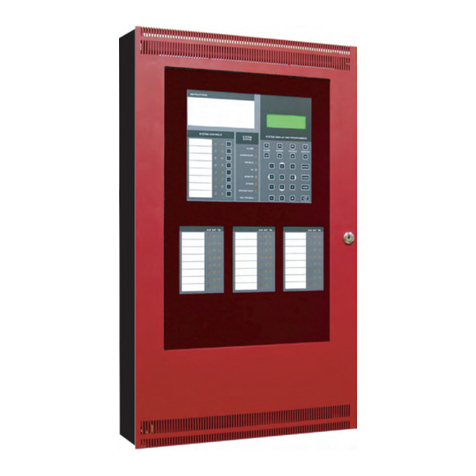
Mircom
Mircom FX-2200 Series Programming manual

Somati system
Somati system SLIDETRONIC II quick start guide
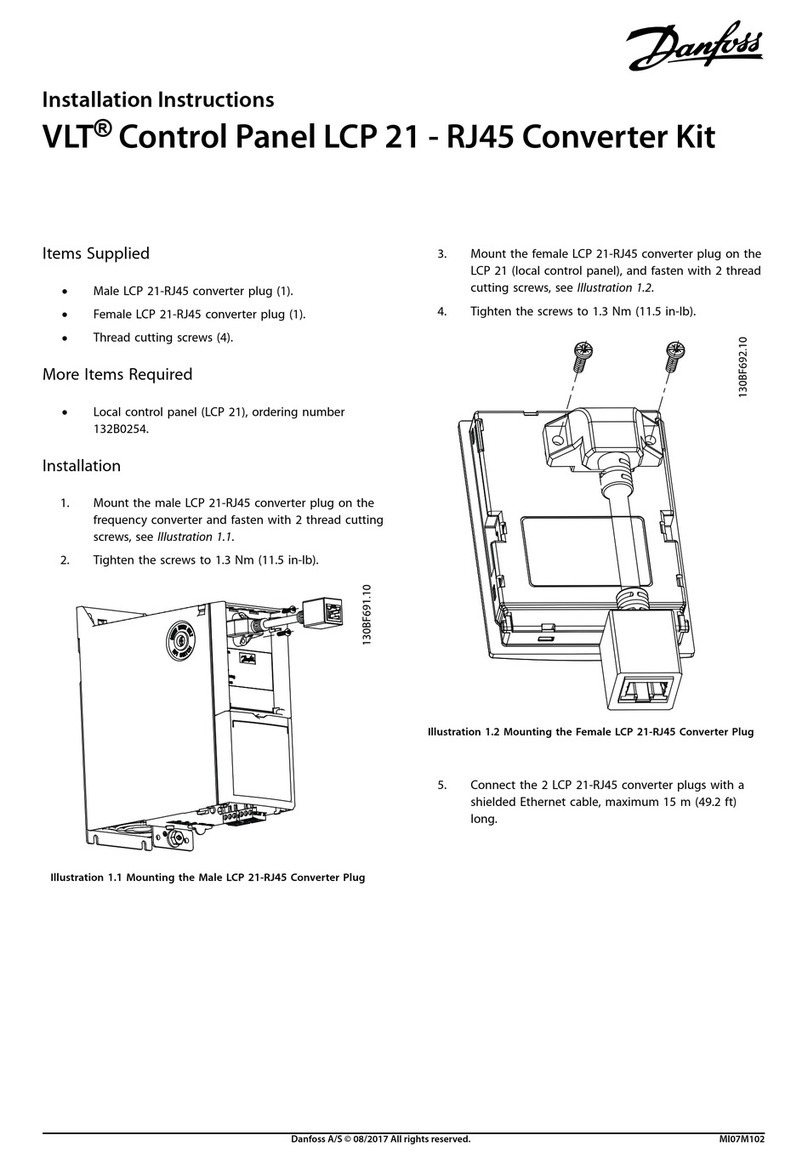
Danfoss
Danfoss VLT LCP 21 installation instructions

Flexit
Flexit SP405 user guide
